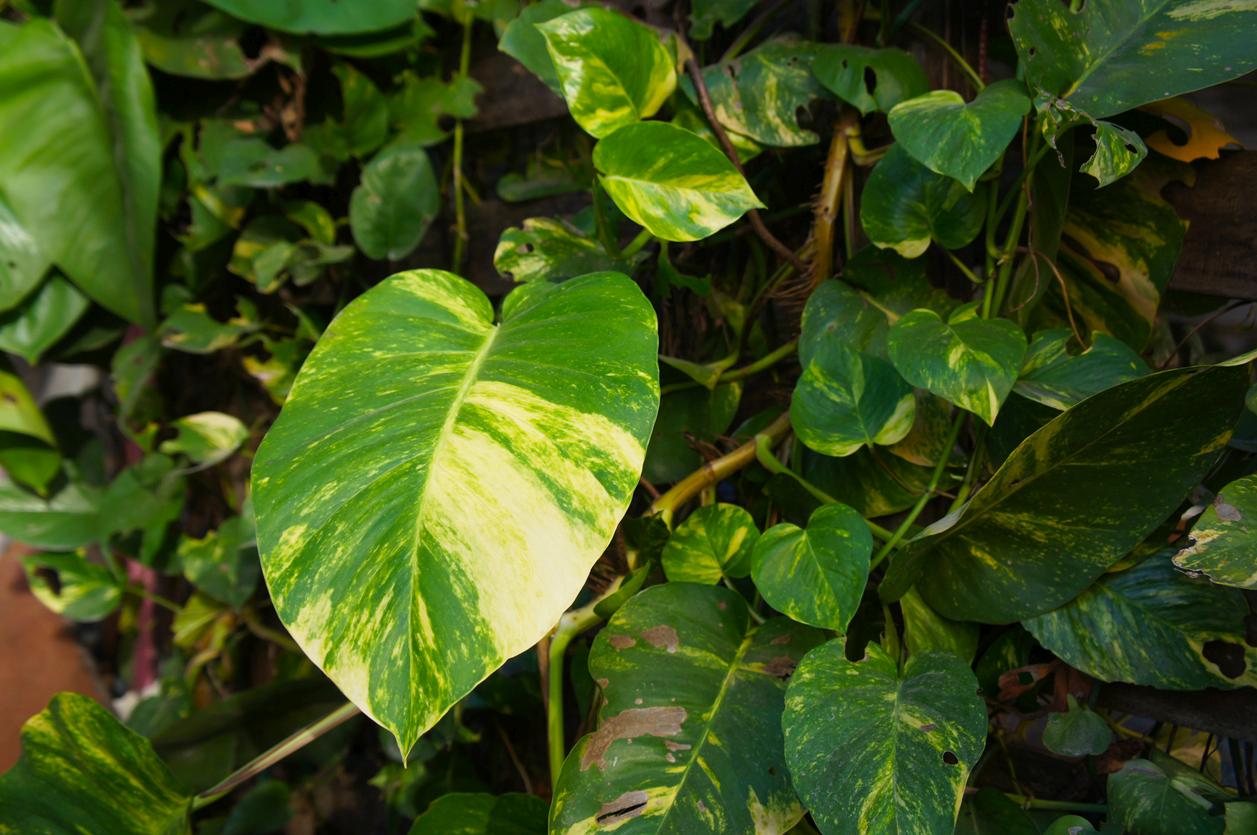Pothos Care: How To Grow, Care, and Propagate The Devil’s Ivy
You’ll see it in balconies dancing merrily in the wind, in living rooms brightening up dark corners, and in offices adding a much needed green shade to an otherwise pale landscape. It’s the pothos or “Devil’s Ivy” as it’s known in some gardening circles.
But there’s nothing dark or sinister about pothos despite its mischievous name. This is one plant that is more associated with brightness, light moods, and sweet summer breezes than anything else. And putting the name aside, you will love everything about this houseplant that has become a fixture of many offices today. So how do you grow, care for, and propagate the ubiquitous pathos? This guide walks you through the necessary steps and what you need to watch out for when growing the Devil’s Ivy.
Pothos at a Glance
Originally from French Polynesia, pothos, or Epipremnum aureum, is a tropical flowering plant that belongs to the family Araceae. But being topical doesn’t mean you can’t grow it in your office or garden where the temperature is more moderate.
Besides its bright and cheerful leaves, there’s something interesting about these leaves. They change in shape and size as the plant ages. In the wild, pothos climbs everywhere and grows to monstrous sizes. But in the office or a limited space, it has a timid demeanor and doesn’t require much pruning. On average it grows to about 6 to 10 feet given enough space and nutritions.
You can grow it over a ledge or the edge of your desk and it will cascade down in a magnificent display of various shades of green. But that’s not the only thing you’ll love about it. The Devil’s Ivy is known to purify the air and remove toxins from the room or office. If you get a lot of benzene or formaldehyde particles in the atmosphere, put a pothos pot in your bedroom to cleanse the air.
Pothos Varieties
The one thing about pothos that really makes it ideal for just about any setting you place or grow it in, is that the vine comes in many varieties. You won’t have to change your decor or interior design to accommodate your living plant. Just pick the right variety that matches your color combinations. Different species of the plant have various shades of green, yellow, and white in exquisite designs. Some cultivars have solid colors and do away with patterns altogether. Here are some of the more popular varieties of the Devil’s Ivy.
- Neon: One of the most popular varieties of pothos. As the name implies, the colors are so vivid they appear to shine in the dark. Put this potted variety in a dark corner to bring light to the room.
- Marble Queen: The exact opposite of the Neon variety. Not that it sucks the light out the room, but that it needs a lot of light to grow successfully. You’ll need to place it on a window sill where it gets flooded with daylight a few hours every day.
- Silver Satin: A somber variety with distinct gray-green colors and white splashes that give it a dignified look. The leaves are thicker than other varieties and it’s more suited for less bright color themes. Or you can place it next to a flashy piece of furniture to tone down the sharp colors.
- Pearls and Jade: A common variety of pothos distinguished with simple green and white designs that make it ideal in many rooms and offices.
How to Grow the Devil’s Ivy
When looking for a houseplant to grow, you couldn’t find anything easier to grow or less demanding than the Devil’s Ivy. The pointed leaves with their attractive patterns don’t need much in the way of nutrition, pruning, or general care.
As we mentioned, if left on its own, the plant’s branches and leaves tend to cascade down freely and gloriously. Pothos is not a natural climber. If you want it to grow on a trellis or support, you’ll have to train it manually. You can twine the branches around the support and the plant will take it from there.
You will need to plan your space carefully before you place your pothos pot in an area. For one thing, this is a vine that grows to 30 feet if you let it. But it’s not just the height. The Devil’s Ivy is a leggy one too. Without pruning, it will spread around and cover as much space as it finds. Luckily you can easily manage that monstrous growth as we’ll see later.
Pothos has USDA hardiness zones between 10 and 11. This means you can grow it easily in your garden or as an outdoor plant if you get enough sun every day. Just keep in mind that with time the leaves drop on the stalk and only the top shows growth. You’ll need to secure the bare stalk with hooks to keep the plant from tumbling to the ground.
Devil’s Ivy Care
While growing the Devil’s Ivy is easy, the same cannot be said about its care and maintenance. Apart from managing its fast and wild growth, you’ll also need to watch out for pests and the plant’s own toxicity. Here are the main areas of care you have to pay attention to.
Light
While pothos is mainly a tropical plant, it still doesn’t like direct sunlight. In the wild, it often grows on the floor of forests and at tree bases where it gets most partial shade. If you plant it in your garden, pick a spot that doesn’t get direct sun. Indoors, it should be near a window facing the south where the daylight is bright for many hours. If the leaves look paler than normal, that means the plant isn’t getting enough light.
Water and Soil
The good news is, pothos isn’t very particular about the kind of soil you grow it in. As long as it’s well-drained, the plant doesn’t mind if it’s a little acidic, sandy, or even dark clay. However, it doesn’t need much watering.
You should hold irrigation until the soil is dry, not just the topsoil, but the rest of the pot as well. Too much water kills the roots which is fatal to the plant as well. A good way to tell that the plant needs water is when the leaves start to droop. Then give it water, but barely enough to make the soil moist. Be wary of long bouts of drought since they affect the leaves and give them a brown tip.
Fertilizer
You won’t need to worry about the nutrients in the soil as far as pothos is concerned. It feeds on whatever is available and doesn’t demand much plant supplements. You can give it a well-balanced liquid fertilizer once every three months to encourage the leaves to grow. But be careful not to feed it too much since it is a fast grower and the branches are known to explode all over the place.
Humidity and Temperature
While the Devil’s Ivy can handle varying temperatures rather well, it still needs warm climates to grow. On average you should keep the room or office above 50 degrees Fahrenheit to avoid any issues with your houseplant. High humidity is preferred but not required.
Toxicity
While pothos is not a toxic plant per se, its leaves contain calcium oxalates crystals. If ingested by a child or an animal, it can cause stomach pain and would require immediate medical help. Symptoms of pothos toxicity include vomiting, nausea, and skin irritation. Keep it away from children and chewy dogs.
How to Propagate Pothos
The easiest way to propagate pothos is to use a cutting. You can either grow the plant in soil or in water. But once you choose a medium, you can’t switch the plant later. As we mentioned the soil can vary in richness and as long as it’s well-drained, your pothos will grow happily without giving you any problem.
Make a cutting at the base of the branch. It should be between 4 to 6 inches long and carry a few leaves at the top with about two growing nodes. Trim any leaves near the base. Now plant the cutting in the pot or container you prepared in advance.
Water the plant immediately and keep the water moist until the roots develop. You’ll know that it’s growing when you see new leaves coming out. If you plant it in a water medium, keep it there for the rest of the plant’s life.
If the pothos plant sheds leaves excessively, that could be a problem with dehydration. Make sure to water it at regular intervals. If the leaves become yellow or show abnormal shape distortions, that could be due to light deficiency. Bring the pot close to a window that gets a few hours of daylight every day.

